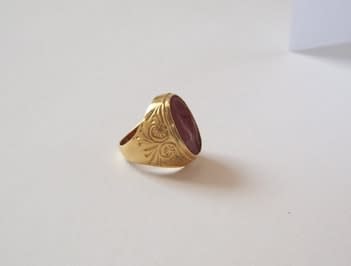Gold Ring Featuring a Roman Jasper Intaglio of the Bust of a Woman, 100 CE - 300 CE
Jasper and Gold
FJ.6789
Further images
This Genuine Ancient Seal Has Been Mounted in a Spectacular Modern 18 Karat Gold Rin The art of glyptics, or carving on colored precious stones, is probably one of the...
This Genuine Ancient Seal Has Been Mounted in a Spectacular Modern 18 Karat Gold Rin
The art of glyptics, or carving on colored precious stones, is probably one of the oldest known to humanity. Intaglios, gems with an incised design, were made as early as the fourth and third millennia B.C. in Mesopotamia and the Aegean Islands. The exhibit a virtuosity of execution that suggests an old and stable tradition rooted in the earliest centuries. The tools required for carving gems were simple: a wheel with a belt-drive and a set of drills. Abrasives were necessary since the minerals used were too hard for a metal edge. A special difficulty of engraving intaglios, aside from their miniature size, was that the master had to work with a mirror-image in mind.
The image of a female figure, possibly an empress or a priestess, has been engraved onto the polished face of this precious gemstone. The masterful carving is extraordinary considering the density of the material and the relatively minute compositional confines of the surface. However, the level of clarity and detail achieved in the image attests to the incomparable workmanship of Ancient Roman glyptic artist. Individual strands of the lady’s hair are evident, falling down in elegant curls around her neck. The artist also conveyed the folds of her toga and the differentiation of textures from her flesh, hair, and drapery, a most remarkable feat. This seal would be stunning by itself; however, it has been elegantly mounted in a luxurious gold ring, a display worthy of the refined beauty of the intaglio itself. This spectacular ring captures an image of picturesque beauty from almost two thousand years ago. Today, she still appears as vibrant and youthful as in the past. She shares her joy with us and our lives are enriched by her eternal charm.
The art of glyptics, or carving on colored precious stones, is probably one of the oldest known to humanity. Intaglios, gems with an incised design, were made as early as the fourth and third millennia B.C. in Mesopotamia and the Aegean Islands. The exhibit a virtuosity of execution that suggests an old and stable tradition rooted in the earliest centuries. The tools required for carving gems were simple: a wheel with a belt-drive and a set of drills. Abrasives were necessary since the minerals used were too hard for a metal edge. A special difficulty of engraving intaglios, aside from their miniature size, was that the master had to work with a mirror-image in mind.
The image of a female figure, possibly an empress or a priestess, has been engraved onto the polished face of this precious gemstone. The masterful carving is extraordinary considering the density of the material and the relatively minute compositional confines of the surface. However, the level of clarity and detail achieved in the image attests to the incomparable workmanship of Ancient Roman glyptic artist. Individual strands of the lady’s hair are evident, falling down in elegant curls around her neck. The artist also conveyed the folds of her toga and the differentiation of textures from her flesh, hair, and drapery, a most remarkable feat. This seal would be stunning by itself; however, it has been elegantly mounted in a luxurious gold ring, a display worthy of the refined beauty of the intaglio itself. This spectacular ring captures an image of picturesque beauty from almost two thousand years ago. Today, she still appears as vibrant and youthful as in the past. She shares her joy with us and our lives are enriched by her eternal charm.





